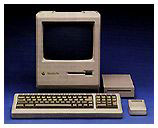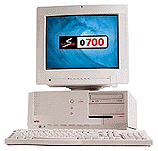Mac Musings
Macs, Elitism, and the Starbucks Demographic
Daniel Knight - 2002.06.12 -
I don't know where the rest of you come down on this, but I'm a bit tired of hearing that Apple and Mac users are elitists. The latest to paint us with this broad brush is Hannibal over on ars technica. His recent column, New Apple ads return to company's populist roots . . . sorta, uses words and phrases including elitist, insulting, high horse, the Starbucks demographic, premium prices, and upscale demographic.
Here at Low End Mac, we don't tend to resemble that at all. Sure, some of us sometimes have shiny new Macs, but most of us started out toward the low end, hold onto our Macs far longer than Steve Jobs would like, and don't consider ourselves upscale or elitist.
For instance, my first Mac cost me practically nothing. I earned
that Mac Plus in an Apple
sales program as the computer was end-of-lifed.  My
total cost was the income tax on the value of the discontinued
computer.
My
total cost was the income tax on the value of the discontinued
computer.
I used that Mac Plus from early 1991 until June 1993. During that time I managed to acquire an external floppy, scrounged up money for four 1 MB SIMMs (two at a time - about $77 each in those days), added a 40 MB hard drive, and scraped up $200 for a Brainstorm 16 MHz upgrade.
I ended up selling the whole system for around $750 when I bought my Centris 610 in June 1993. That sale covered about half the cost of the new setup. With 4 MB RAM, an 80 MB hard drive, and a 20 MHz 68LC040 processor, I thought I'd died and gone to Mac heaven. Although Apple offered 33 MHz machines like the Quadra 800, compared with the 25 MHz 68030-based Mac IIci I used at work, the C610 positively screamed.
Over time I bumped VRAM to the 1 MB max, added first one 4 MB SIMM and then another, replaced the hard drive with a 270 MB one, and eventually replaced a 4 MB SIMM with a 16, giving me a very comfortable 24 MB system. And I didn't even have an internal CD-ROM, just a poky old 1x external NEC drive that I rarely used.
That computer was the middle of the pack when I bought it. By June
1998, over a year after I'd begun Low End
Mac, it was feeling pretty long in tooth.  Looking
at the cost of a QuadDoubler, a bigger hard drive, more memory, and a
decently fast CD-ROM, I determined that the just discontinued
SuperMac J700/180 at a fire
sale price of about $800 made economic sense. (By way of comparison,
Apple had released the first G3 models in November 1997.)
Looking
at the cost of a QuadDoubler, a bigger hard drive, more memory, and a
decently fast CD-ROM, I determined that the just discontinued
SuperMac J700/180 at a fire
sale price of about $800 made economic sense. (By way of comparison,
Apple had released the first G3 models in November 1997.)
From a 20 MHz LC040, 270 MB hard drive, 1x CD-ROM, and 24 MB of memory to a 180 MHz 604e, 2.1 GB hard drive, 8x CD-ROM, and 24 MB of memory was an impressive step. Again, it outperformed the computer I had at work.
But step back and do the math. I'd used the Centris 610 for a full five years with a few very economical upgrades. My net cost after subtracting what I got for the Plus and what I got for the 610 was under $1,000 - that's less than $200 a year to use a computer.
Likewise, the J700 lasted for years, albeit with several upgrades along the way (CPU, RAM, hard drive, video card, and more). At one point I had so many upgrades that I bought a stripped S900 (case, motherboard, power supply, and floppy) and moved all my better components into it, putting the J700 close to it's original state.
I finally replaced that setup at the end of January 2001, when the first 400 MHz PowerBook G4 reached my dealer. For a while I let the kids use the J700 and S900. My oldest eventually picked up his own used S900, my second son is using a secondhand iMac/333, my third has a 266 MHz WallStreet and also uses my old S900, my fourth uses another secondhand iMac/333 as well as the beige G3/266 I've set up with OS X.
The old J700? It's handling backup for our network of computers, so it's still in active duty four years after it was purchased - and its design was already two years old in 1998.
Today you can buy a PowerBook G4 that will run circles around my old 400 MHz model. The new one's CPU is twice as fast, has a larger cache, uses a much larger hard drive, can burn CDs, has a higher resolution screen, and includes accelerated graphics - yet I'm living comfortably at 400 MHz, far behind the trailing edge of today's new Mac market.
I realize my family isn't typical. Most Mac users don't have at least one computer for each member of the family. (My wife uses a 14" iBook supplied by her business.) Most don't have a large ethernet network, a shared Internet connection, a dedicated file server, or a network backup system.
But they could.
I've run websites and mail servers on a Mac II, used various Quadras as file servers, and had my old Centris act as a software router for an ISDN modem. The beauty of low-end Macs is that they're cheap, reliable, and versatile. You can afford to dedicate an inexpensive computer to a task like sharing your Internet connection or making files available to everyone in your household.
Yet as Mac users, we're sometimes painted as elitists, lumped together with the Starbucks crown, and told we represent an upscale demographic. I don't think ars technica's Hannibal knows the same Mac users I do.
It's not that we're opposed to what's new and great. After all, Low End Mac owns a TiBook. But it was selected not because it had a fast G4, but because it was the first PowerBook ever with a big enough screen for the way I work. And it's going to remain my workhorse for the foreseeable future, regardless of site finances.
Much to the chagrin of Jobs and Co., most of us don't replace our Macs because we can. We upgrade when we must, and we replace when upgrades won't get us where we need to be. We look to value, not bragging rights. We see our Macs as tools, not status symbols.
Sure, Macs may cost more initially, just like Volvos and Snap-On Tools, but a quality tool that works well and lasts longer justifies some additional expense up front. Unlike the Wintel crowd ars tech and similar sites cater to, we're not always looking for faster processors, bigger hard drives, and better 3D gaming. We don't plan on replacing components annually and whole computers every 2-3 years.
Low End Mac is about value, and I believe that the Macintosh has always been about value, whether we're looking at the 1984 Macintosh for $2,500; the overweight 1989 Mac Portable at $6,500; the "wicked fast" 1990 Mac IIfx for $10,000 plus monitor, keyboard, and accelerated video card; the amazing 1993 Quadra 840av for $4,700; or today's entry-level 600 MHz G3 iMac for $800.
Not only do we tend to use our Macs longer than Windows users keep their PCs, but we rarely put them in the trash. Macs are known and loved and repurposed. Even an old Quadra can browse the Web, handle email, and be used for word processing and spreadsheets. For those who have no computer, old Macs are gems - and Apple even makes System 7.5.x available for free to owners of older Macs.
Sure, some elitists buy Macs because they look great, have awesome flat panel displays, and cost a lot, but most Mac users are far more pragmatic than that. From the grade schooler writing a book report to the video editor on a dual gigahertz G4, we want to get the job done without having the hardware, software, and OS get in the way. We just want to be productive.
The fact that Macs tend to be better built, more stylish, and a bit more expensive doesn't make them elitist, any more than not choosing a black Model T made Chevrolet buyers of the 1920s and 30s elitist. We simply have different standards for usability than the masses with their Model T "Intel Inside" boxes running Microsoft Windows. And maybe some Starbucks devotees think that way, too.
But a lot of teachers, parents, students, writers, artists, and others pick the Mac, including old fashioned java drinkers and Diet Coke fans. We know what we like.
The Macintosh has always brought computing power to "the rest of us," the kind of people who don't want to buy Dummies books before they can be productive with their tools. And then we have to contend with people calling us elitists on the one hand and accuse Apple of dumbing down the user interface on the other.
You can't have it both ways.
Maybe the true elitism looks down on those who follow the less taken path. For Mac users, following that path has made the difference.